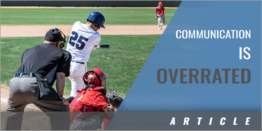| How to know if a pitcher is hurting
A coach walks to the mound and asks "How do you feel?" The pitcher says "Fine coach." Sound familiar? It should because in high school and above, that's pretty much all you are going to get from any pitcher.
Most pitchers are not forthcoming when it comes to hurt arms. Reasons for doing so vary. Some fear losing their current role to another player. Others don't want to be thought of as weak. Some are extremely competitive and just don't want to stop playing. So how is a coach supposed to know if a pitcher is really "fine" or trying to hide an injury? First of all, a coach cannot simply say "He told me he was fine so I let him continue pitching." Although some of the responsibility must be on the player, coaches should go into the situation knowing that athletes have real incentives to not tell the truth. As a result, coaches must be observant to the clues that pitchers provide to determine if the pitcher is actually hurting. Below are some of the things that may indicate an injury. Note: The items listed below are not to be taken as clear evidence of an injury. What is listed are things that may indicate a problem and therefore are worth keeping an eye on. General loss of command. Every pitcher is going to have games where they lose command of the strike zone. However, it could also be a sign of an arm that is hurting. Often a lack of command is caused by an inconsistent release point. An inconsistent release point can be caused by an arm that hurts when it gets to its normal release point. The pitcher changes his release point to ease the pain and a loss of command results. If a pitcher with fairly good command loses it, especially over the course of a few outings, it might be a red flag. Wild up. A pitcher who is wild up in the zone could very well just be too amped up and trying to throw too hard. It also can be the result of a shoulder problem. To bring the fast ball down in the zone, a pitcher needs to get good arm extension out in front of the body. However, the pain associated with a shoulder problem often occurs most when the pitcher tries to get this extension on the pitch. To avoid the pain, the pitcher shortens up on the extension which tends to bring the ball up in the zone. Loss of velocity. This is one of the reasons why Major League teams use radar guns and chart every pitch. It's not just a curiosity. It can be a clue of a problem if velocity drops. It makes sense that if a player hurts when arm speed is 100% then the player may decrease arm speed to avoid the pain. Most programs below the college level do not have radar guns to monitor pitchers so coaches have to become attuned to noticing changes in a pitcher's arm speed on the pitch. Video analysis can help but often a coach with a sharp eye can notice just as easily. Pitch selection. Ever see a hard thrower go to his off-speed pitches way too much? How about an off-speed pitcher suddenly try to become a fastball pitcher? This could be the result of a pitcher simply losing some confidence in his "stuff" but it can also be a clue to a possible injury. As stated above, a fastball pitcher may ease up on the arm speed and/or avoid getting full extension on the pitch to alleviate the pain. In this pitcher's mind, becoming an off-speed pitcher accomplishes both. Breaking pitches do not require the pitcher to get the full extension they would need on a fastball. Although mechanically incorrect, some pitchers also view "slower speed pitches" with "slower arm speed." They feel that slowing the arm speed a little will cut down on the pain. On the other side, an off-speed pitcher may be switching to the fastball due to elbow pain caused by breaking pitches like curveballs, sliders, and cutters. Arm drops. This clue is seen when a pitcher changes his arm angle at the release point for no apparent reason. An over-the-top thrower may all of a sudden become a ¾ guy. A ¾ guy may become a side-armer. It could just be that the pitcher is trying something new on the batter but it could also be a sign of a shoulder problem. Shoulder pain usually becomes more intense the more a pitcher lifts his arm. This is why a pitcher drops his arm on the throw so as to avoid the additional pain. Suspicious body language. Of all the injury clues that are provided by pitchers, you would think that this one is the most easily seen. However, if coaches are looking at the pitcher at the wrong time, they often miss the obvious. In baseball, most eyes follow the path of the ball. The pitcher lets go of the ball and all eyes go to the batter to see what happens next. Unfortunately, if you do this, you often miss the body language of the pitcher immediately after the release of the pitch. Now and then, and especially if you think there may be a problem, DON'T TAKE YOUR EYES OFF THE PITCHER. No matter where the ball is thrown or hit, keep your eyes locked on the pitcher. Facial expressions of pain (winces, etc.) and other subtle body language signs that indicate pain often occur as the ball is traveling towards home plate. Pitchers are usually good at hiding pain if they are standing on or walking around the mound. They won't be able to hide the pain at the time when the pain actually hits - usually at or beyond the release point. Other subtle things to look for during games include the following: • Frequent squeezing of the hand on the mound or bench (possible sign of elbow pain) A lot of this comes down to knowing the normal patterns of a pitcher and comparing them to what you are currently seeing. It would be very nice (and easy) if pitchers were always honest and told us exactly what's going on. That's not likely to happen very soon so it becomes imperative that coaches recognize the signs of an injury.
|
|
|







